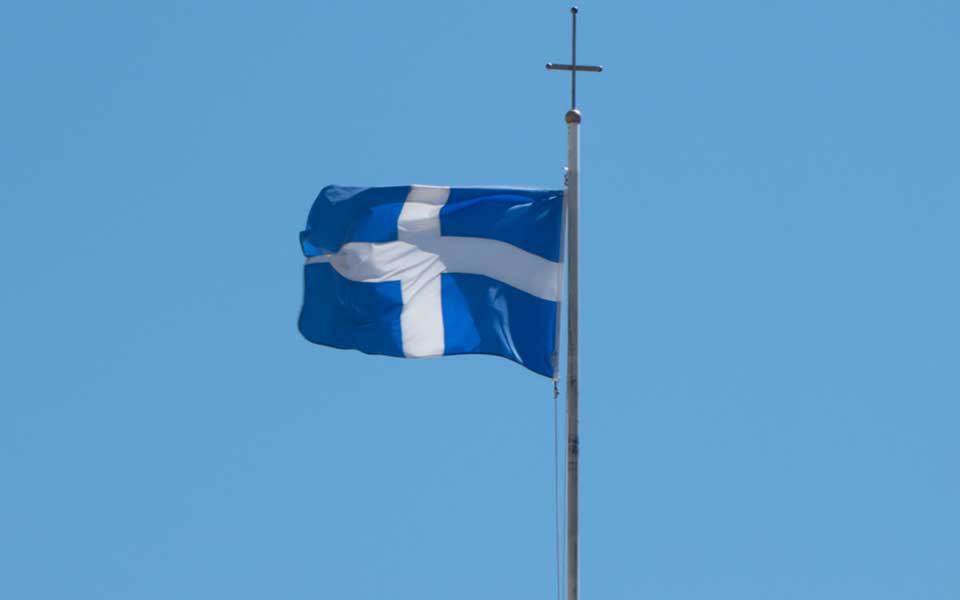When we picture the landscape of Greece, images of Cycladic islands in the heart of the Aegean, with their characteristic whitewashed architecture, blue shutters and taverna chairs, best encapsulate the scene.
Indeed, blue and white are the colors we most associate with Greece; cloudless blue skies, the white crests of waves on the horizon, and, of course, the myriad shades of blue sea. It’s fitting, therefore, that blue and white feature on the universal symbol of Greek national identity – the flag.
The national flag of Greece, instantly recognizable by its blue and white, cross-and-stripe pattern, was officially adopted by the Greek state in December 1978. Its origins, however, can be traced back 200 years to the First National Assembly of December 1821-January 1822, less than a year after the start of the Greek Revolution.
Popularly referred to as the “blue and white” (Γαλανόλευκη), the Greek flag is a potent mix of symbolism. A popular tradition states that the nine horizontal stripes of blue alternating with white represent the syllables of the phrase “Freedom or Death” (Ελευθερία ή Θάνατος), a war cry against Ottoman rule. Another theory holds the stripes symbolize the nine Muses, ancient Greek goddesses of literature, poetry, science and the arts.
Whatever their significance, it was on January 13, 1822, that an earlier version of the current design was first adopted – the square “Land Flag,” a white cross on a simple blue field (background).



© Shutterstock
Prior to the Greek Revolution, a number of banners and flag designs were already circulating around the region, many incorporating Christian emblems and symbols from the Byzantine empire, including St. George and the Dragon, and the famous double-headed eagle.
During Ottoman rule, merchant ships owned by Orthodox Christian subjects (Rûm) were permitted to fly a civil ensign, combining red and blue stripes – the red representing the Ottoman empire, the blue for Christian Orthodoxy.
During the uprising of 1769-1771 – the Orlov Revolt, a major precursor to the War of Independence – a blue cross on a white field became a popular flag, widely adopted by revolutionaries in the lead up to 1821.
First Greek National Assembly
Convening in Epidaurus in December 1821 and January 1822, delegates at the First National Assembly wanted to portray nascent Greece as unified and orderly, ready and willing to take its place at the high table of European nations.

© Shutterstock
Dissolving the often fractious regional councils in favor of a more centralized administration, they also decided to abolish all revolutionary flags and adopt a single national flag – the white cross on blue (“cyan” – κυανός) – a symbol of their universal struggle against Ottoman rule.
Two months later, on March 15, 1822, three patterns were decreed by the President of the Executive Alexandros Mavrokordatos: the Land Flag (white cross on blue), which would function as the national flag; the first “Sea Flag” (blue with a blue cross on a white field in the top left canton/corner), to be flown by merchant ships as a civil ensign; and the second sea flag (nine alternative blue and white stripes with a white cross on a blue field in the top left canton), flown as a naval ensign by warships – the flag we know as the national flag today.

© Shutterstock
The second sea flag, or naval ensign, quickly became popular among Greeks during the Revolution, and was often hoisted alongside the land flag.
The national flag of Greece was internationally recognized for the first time on February 7, 1828, receiving official salutation from British, French and Russian forces in Nafplio, Greece’s first capital.
Shades of Blue
While white and blue have been variously described as representing the colors of the Greek sky and sea, it is interesting to note that the shade of blue used in the flag has varied considerably throughout its 200-year history. According to the most recent legislation regarding the national flag, the citation (Law 851/1978) mentions nothing about the shade of blue:
“The National Flag of Greece is cyan and white, it is made up of nine (9) stripes equal in width, of which five (5) are cyan and four (4) are white that the upper and lower stripes are cyan and the others in between are white.”
As a result, the shade of cyan (blue) has run the gambit from sky blue, adopted during the early years of the Greek monarchy, to a much darker blue, used in the later 20th century.
Today, the shade of blue is largely left up to the flagmakers to decide.












